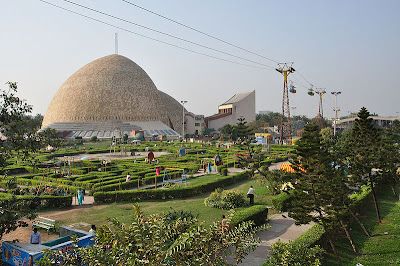
Not to be harping on
my pretty new map or anything, but in the event it proves too long to browse for those with limited time, I'll point out some highlights I found along the way in my international research!
The
American Roadtrip highlights are great, but if one's budget allows for more exotic locales, head to India! The National Council of Science Museums (NCSM) under India's Ministry of Culture is the world's largest chain of science centers under a single administrative umbrella.

Science City, Calcutta, India
Unsurprisingly, they thus host the world's largest space theme park,
Science City Kolkata. Their stated goal is:
"To portray the growth of science and technology and their application in industry, human welfare and environment, with a view to develop scientific attitude and to create and sustain a general awareness amongst the people."A fine mission, and they accomplish it with interactive experiments, IMAX, Earth exploration exhibits, motion simulators, models, maritime displays, live animals, an evolution park and… roller coasters. No joke, they have rides everywhere – but this is not to say that it detracts from the amazing array of educational science; I was totally blown away by the sheer size and comprehensive nature of everything described on
their website!

Space City, Toulouse, France
Another amazing theme park is the
Cité de l'espace, or "Space City" in Toulouse, France. Among their unique features are an Earth TerraDome, a moonwalk simulator and a
Stellarium, described as an astronomical simulator with a hemispherical screen. They also feature rides and interactive experiments for those aspiring to be astronauts or scientists, or for folks who simply want to see what it's like to live on the International Space Station.
Their outdoor park features a Soyuz capsule, an Ariane 5 rocket and full-size replica of the entire MIR space station, that was, once upon a time, used for analog ground testing! And don't skip the Alien Encounter.
America clearly doesn't hold the patent on schmaltz.
Universum, Bremen, Germany
Perhaps the most interesting architectural novelty I found was the
Universum in northern Germany... another shining example of how every technological culture develops a fascination with UFOs! Like the science park of India, they tell multiple stories about the natural world and humankind, exploring the history of human technology from fossil evidence up through the space-faring years.
From the Big Bang to their research labs, they allow people hands-on exploration of scientific experiments, and then they threw in a WaterWorld for good measure. And an array of restaurants. Playful park options include the Moon Jumper, gyroscopes, and science shows at the outdoor arena.

Noesis, Thessaloniki, Greece
Lastly, I'll feature the
Noesis, an amazing set of structures in Greece, on the Aegean coast. Like all the others, it features a mall and a planetarium as standards, but it's big local draw is obviously the ancient Greek technology. Their "Technopark" is a themed space odyssey, in perhaps one of the most unique buildings I've ever seen.
It rather begs the question – why is there no equivalent SPACE CITY anywhere in America? And I don't mean a NASA center. We should have a theme park with flying saucer rides!
I have a map. If you happen to be an eccentric billionaire with time on your hands, please pick a spot.
I'll help build.






































